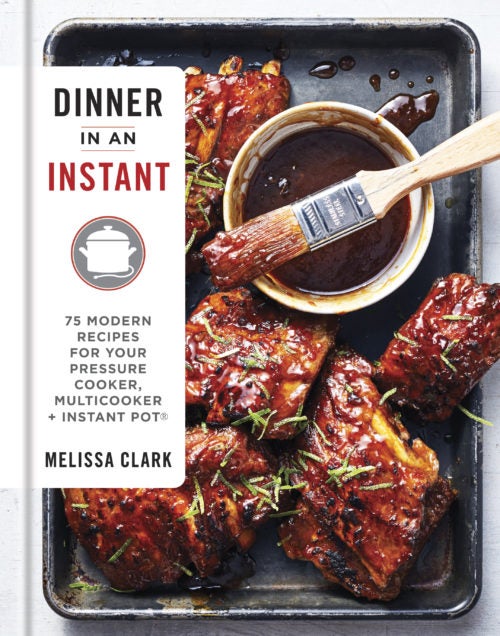






Filled with herbs and seasoned with aromatic saffron butter, this green and orange–flecked rice dish is magnificent, made even more so by its crunchy, buttery, golden bottom crust called a tahdig. Creating the tahdig, which requires a stint on the sauté setting after the rice and herbs are cooked under pressure, takes some practice and finessing, so don’t be upset if it doesn’t work out perfectly the first time. There’s an art to knowing when to take the pot off the heat. If some of the crust sticks to the pot, just scrape it out and lay it on top of the rice for serving. Then make sure everyone gets at least a small piece of it to savor. Those of you with nonstick pots in your pressure cookers will have a much easier time unmolding this. But stainless steel pot owners, fear not; if you’re nervous, err on the side of undercooking the tahdig. Better lightly golden than burnt. In any case, with all the saffron and herbs, it will still be delicious. And when you do eventually turn out a perfect version, be prepared for the oohs and aahs. They will be copious. This is a dish worth mastering.
Directions
- Rinse the rice in a fine-mesh sieve for several minutes, until the water runs clear; then transfer it to a medium bowl. Cover the rice with warm water and let it sit while you prepare the herbs.
- Place the herbs, with any tender stems, in a food processor and pulse until finely chopped. (Or you can do this by hand with a knife.) You should have about 2½ cups finely chopped herbs.
- Brush the bottom of the pressure cooker with the 1 tablespoon softened butter. Drain the rice, and then sprinkle one third of the rice over the bottom of the pot. Top with half of the chopped herbs, ½ tablespoon of the dried dill, and ¼ teaspoon of the salt. Layer another third of the rice on top, and repeat the herb, dill, and salt layers. Top with the remaining rice and then pour in 2 cups of water.
- Cover and cook on high pressure for 4 minutes. Release the pressure manually, remove the lid, drape a clean kitchen towel on top of the pot, and loosely replace the lid or place a large plate on top. Let the rice sit for 10 minutes.
- Meanwhile, grind the saffron in a mortar and pestle. Pour 2 tablespoons of the oil into the mortar, swirl it around, and then pour the saffron oil into a measuring cup with a spout. Repeat with the remaining 2 tablespoons oil, scraping the mortar to get every last bit of saffron. Stir the melted butter into the saffron oil.
- Remove the kitchen towel from the pot. Using the handle of a wooden spoon, poke holes through the rice all the way to the bottom. Pour the butter mixture over the rice, being generous in the center (most pressure cookers tend to have bottoms that slope down from the center, so the butter will slide to the sides). Turn on the sauté function and cook until the rice is browned and crispy on the bottom, 8 to 12 minutes.
- Turn the pressure cooker off and use a rubber spatula to loosen the rice around the sides and at the bottom of the pot. Remove the pressure cooker pot (using oven mitts or kitchen towels—the pot will be hot). Invert a large platter on top of the pot, and then quickly flip them over together so the rice falls onto the platter, crunchy side up. Or, if you’re hesitant to do that, simply scoop the rice onto the platter so that the crunchy side is on top.

